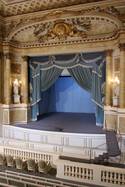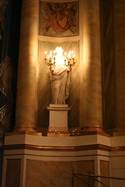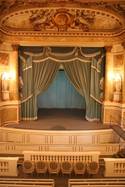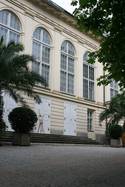Royal Theatre in the Old Orangery
Agrykoli 1 | |
| show on the map | http://www.lazienki-krolewskie.pl/ |
Important events
premiere: Molière, Georges Dandin, Charles Collé, La partie de chasse d’Henri IV (Henry IV’s Hunting Party)
Restoration work, converting basement into cloakrooms and smoking room, stage rebuilt, trapdoor built.
People
The architect of Italian origin. From 1761 he worked mainly on the order of King Stanislaw August Poniatowski, and the aristocracy related to the court.
Italian painter of sceneries and curtains, landscape painter. He worked independently in 1817-1829 and then in Estate Theatre in 1835, in Warsaw 1829-1831, in Dresden 1832, in Vienna 1833, in Berlin 1834. Since 1835 he worked in Poland dup to his death. He proceeded from late Baroque theatre sceneries; he headed towards panoramic Naturalism under influence of French theatre painters.
In: Adéla Anna Vavrečková: Živé příběhy. Divadelní budovy v Olomouci a v Moravské Ostravě. Brno2007. Diplomová práce. Note. 7
More theatresdriving a chariot drawn by four horses, curtain with nine Muses on Parnassus.
History
Located in the Old Orangery in Łazienki Park, this is an authentic 18th century court theatre, the only one still preserved in Poland. It was erected from 1784 to 1788 on the order of King Stanisław August Poniatowski by the Italian architect Domenico Merlini. The impressive illusionistic painted ceiling shows Stanisław August as Apollo on a quadriga, painted by Jan Bogumił Plersch, the king’s court painter. In the corners are images of the best playwrights according to the king’s opinion: Sophocles, Shakespeare, Molière and Racine. The theatre is still used for performances, concerts and classes. In another part of the Old Orangery the royal collection of sculptures is presented. The lovely park also features an 18th century open-air theatre.
Teatr Królewski w Starej Oranżerii • ul. Agrykoli 1 • 00-460 Warszawa • Poland • Tel.: +48 22 506 00 28, +48 22 506 01 83 • rezerwacje(at)lazienki-krolewskie(dot)pl •www.lazienki-krolewskie.pl
Visits: by appointment during the Royal Łazienki Museum opening hours
Tourist information
Tel.: +48 22 194 31
info(at)warsawtour(dot)pl
www.warsawtour.pl
From 1784 to 1788, an impressive Orangery building was built to a design by Domenico Merlini in Łazienki, a park surrounding King Stanisław August Poniatowski’s palace. In the Orangery’s east wing there was a private, royal theatre. In the 18th century, putting theatre rooms in orangeries was quite common. It can be assumed that the Royal Theatre in the Old Orangery was inspired by the mansion in Rydzyn, where the king used to visit his friends. Another theatre in an orangery was at a residence owned by the Mniszek family in Dukla.
Merlini, an Italian settled in Poland, was the king’s architect, and between 1773 and 1797 was the Royal Architect in Poland. He designed and rebuilt many public buildings, manor houses, palaces and aristocratic town houses, at first in a late-Baroque style, later in a Classical style. The royal buildings in Łazienki are his most famous work.
The theatre entrance is through a triple door in the front elevation and is dominated by seven high, arcade windows on the first floor. The stage is separated from a similar sized auditorium by two pairs of Corinthian columns and an orchestra pit. The auditorium has rows of benches placed amphitheatrically, with nine dress circle boxes; it is surrounded by double Corinthian pilasters. Three boxes opposite the stage were reserved for the king and his family. Above the real boxes there are trompe l’oeil ones with spectators, an unusual image of an 18th century audience: elegant ladies wearing sophisticated headgear and men in Old Polish outfits and tailcoats leaning over the balustrades above the heads of the real audience. A circular ceiling shows Apollo on a quadriga surrounded by putti. Around the ceiling there are four medallions with images of outstanding playwrights: Sophocles, Shakespeare, Racine and Moliere. According to Barbara Król-Kaczorowska, the idea of ornamenting the theatre interiors with portraits of dramatists was neither new nor innovative. The king had decided upon it, thereby proving his knowledge and esteem. The same is true of the popular motif at that time, of nine Muses on Parnassus, painted on the curtain in the theatre (by Jan Bogumił Plerch) and a complementary element to the ceiling paintings. Above the stage is the coat of arms of the Republic of Poland, with the king’s emblem supported by winged geniuses of fame (beneath it are the signatures of Plersch and Staggi the stucco artists).
During the inauguration on 6 September 1788, amateurs from aristocratic families played Moliere’s Georges Dandin (George Dandin) and Collé’s La partie de chasse d’Henri (Henry IV’s Hunting Party) in French. On 14 September, during the ceremonial celebrations of the anniversary of the greatest victory over the Turks near Vienna (1683) and the unveiling of the Jan III Sobieski monument, a courtly ballet composed by Stanisław August himself and a cantata were performed in honour of the victory. From 12 June to 8 September 1791, during the rebuilding of Teatr Narodowy (the National
Theatre), the director of the national theatre group, Wojciech Bogusławski, and his company performed in the Orangery. In order to help the actors, the king paid for the costs of the performances and the audience entered free of charge. After Poland lost its independence as a result of the partitions, the tsar bought Łazienki in 1817 and the theatre was used only occasionally. Antonio Sacchetti, the decorator of the Teatr Wielki (Grand Theatre), painted a new curtain representing an Alexander I troop column in front of the Winter Palace in Petersburg. In 1916, after a thorough renovation in which the old sets and curtains were destroyed, the theatre was opened on 27 May with Jan Lechoń’s playlet W pałacu królewskim (In the royal palace) and a concert.
A subsequent renovation was carried out after World War II, consisting mostly in the modernisation of stage devices (the only present-day remainders of the old devices are winches for moving scenery and a thunder machine). The ceiling and wall paintings were renovated and a fire protection system was installed. The corridors surrounding the stage were turned into a permanent Gallery of Polish Sculpture. At present, because of its enormous value as a monument, the theatre is rarely open for performances or celebrations.[1]
[1] Barbara Król-Kaczorowska, Łazienkowski Teatr w Pomarańczarni, Warszawa 1961; Barbara Król-Kaczorowska, Teatry Warszawy. Budynki i sale w latach 1748–1975, Warszawa 1986.
Literature:
- Król B., Teatr w Starej Pomarańczarni w Łazienkach „Pamiętnik Teatralny”, 1952, No. 2–3.
- Król B., W sprawie autorstwa malowideł w łazienkowskiej Pomarańczarni, „Biuletyn Historii Sztuki” 1958, z.3–4.
- Król – Kaczorowska B., Łazienkowski teatr w Pomarańczarni, Warszawa 1961.
- Król - Kaczorowska B., Teatr Dawnej Polski. Budynki, dekoracje, kostiumy, Warszawa 1971.
- http://www.lazienki-krolewskie.pl/site,id,49.html
Author: Jarosław Komorowski
Jarosław Komorowski:
Royal Theatre in the Old Orangery, Theatre on Krasiński Square, Theatre in the Castle Museum, Opernhaus, Amphitheatre in Royal Łazienki, Theatre Room in the Castle of Wacław Rzewuski, Theatre of Antoni Sułkowski, Theatr of Sapieha in Różana, Fencing School, Collegium Nobilium Theatre, Theatre building near Hetman Jan Branicki’s palaceAdditional information
No information has yet been entered
Add information























